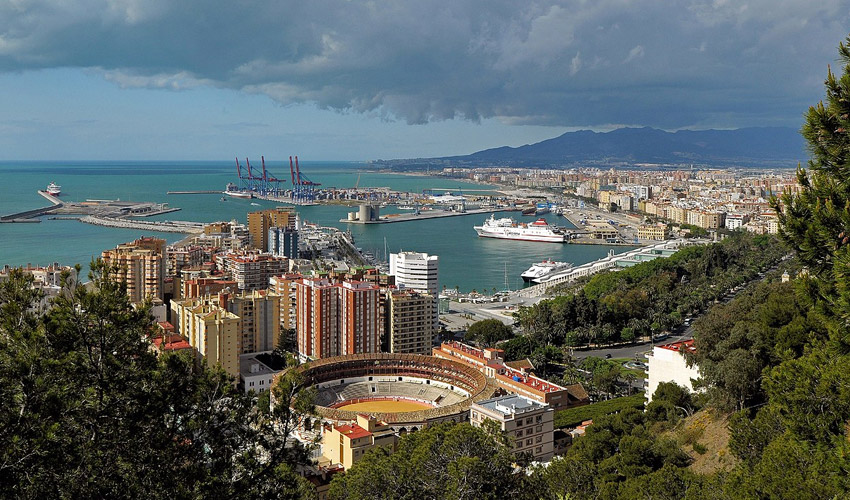Málaga

From the outside, this city has a subdued and modern shell. The historic, Gothic heart of town is another world completely. This is the birthplace of Picasso, and has a large collection of museums to enjoy. Those seeking older historic sites will enjoy the Roman theater, and Azcalba, the Moorish castle. The grand 11th Century Gibralfaro castle is a must-see for those who love lavish manors. Malaga is well-known for its tapas bars and has a reputation of being one of the tastiest cities in the region when it comes to this kind of cuisine.
Beyond its 16 sunny beaches, this Andalusian city on the shores of the Mediterranean has a fascinating cultural side. And the birthplace of Pablo Picasso has reinvented itself in recent year, inaugurating museums for all tastes.
If you take the combination of sea and culture and add a lively atmosphere, plenty of tapas served in its bars, fashionable neighbourhoods like Soho, areas such as the port that have been transformed to offer a more modern image, and monuments with centuries of history, the result is an exciting city everyone would want to discover. Because if everyone says that Malaga is prettier than ever then it must be true.
But Malaga doesn’t only live on its past. In recent years it has inaugurated the Carmen Thyssen Museum, the only Pompidou Centre outside France -its coloured cubes have become an icon- or the Saint Petersburg Russian Museum Collection
.But anyone looking for a more underground culture simply must visit the Centre for Contemporary Art, the urban art on the city’s buildings or the alternative establishments in Soho.
Back to La Malagueta, nearby you can find Muelle 1, a port promenade full of shops and restaurants that is perfect for a sunset stroll to La Farola, a lighthouse that is a symbol of the city.
Another emblem of Malaga? Without a doubt its pedestrian street Marqués de Larios, a busy thoroughfare decorated with flowers and which you must visit at least once on a trip to Malaga. At night, this area and its nearby streets become the perfect spot for tapas at establishments that have become an institution, such as Bodega El Pimpi; and for trying the ajoblanco chilled garlic soup.
Malaga is also known for its Film Festival, its Holy Week, its innovative restaurants... But above all, Malaga is joy. And it's catching.
Beyond its 16 sunny beaches, this Andalusian city on the shores of the Mediterranean has a fascinating cultural side. And the birthplace of Pablo Picasso has reinvented itself in recent year, inaugurating museums for all tastes.
If you take the combination of sea and culture and add a lively atmosphere, plenty of tapas served in its bars, fashionable neighbourhoods like Soho, areas such as the port that have been transformed to offer a more modern image, and monuments with centuries of history, the result is an exciting city everyone would want to discover. Because if everyone says that Malaga is prettier than ever then it must be true.
A journey in time
Malaga is a city full of historical spots such as the Alcazaba, one of the largest Moorish fortresses in Andalusia, or Gibralfaro Castle, which offers the best views over the city. At the foot of the castle there is a Roman theatre and an old town to stroll around. Its streets offer attractions such as the Atarazanas Market to have a vermouth, and monuments like the Cathedral, known as ‘La Manquita’ (one-armed), due to its unfinished right tower. You can’t miss visiting its roof; a unique experience. Here in the city of Picasso, you can visit the excellent Picasso Museum in the centre, and the home where he was born.But Malaga doesn’t only live on its past. In recent years it has inaugurated the Carmen Thyssen Museum, the only Pompidou Centre outside France -its coloured cubes have become an icon- or the Saint Petersburg Russian Museum Collection
.But anyone looking for a more underground culture simply must visit the Centre for Contemporary Art, the urban art on the city’s buildings or the alternative establishments in Soho.
Essence of Malaga
Several things make Malaga a unique place. To start, beyond its monuments, a sunny day spent on the legendary La Malagueta urban beach is a must. Anyone who wants to delve into traditional flavours should visit the seaside neighbourhood of Pedregalejo and try the typical grilled sardines on skewers.Back to La Malagueta, nearby you can find Muelle 1, a port promenade full of shops and restaurants that is perfect for a sunset stroll to La Farola, a lighthouse that is a symbol of the city.
Another emblem of Malaga? Without a doubt its pedestrian street Marqués de Larios, a busy thoroughfare decorated with flowers and which you must visit at least once on a trip to Malaga. At night, this area and its nearby streets become the perfect spot for tapas at establishments that have become an institution, such as Bodega El Pimpi; and for trying the ajoblanco chilled garlic soup.
Malaga is also known for its Film Festival, its Holy Week, its innovative restaurants... But above all, Malaga is joy. And it's catching.

 Spanish
Spanish German
German Dutch
Dutch